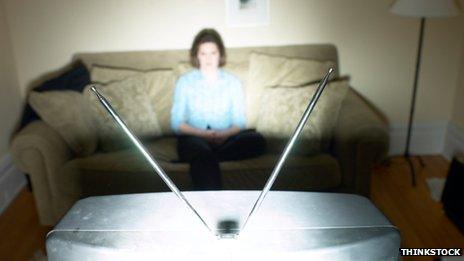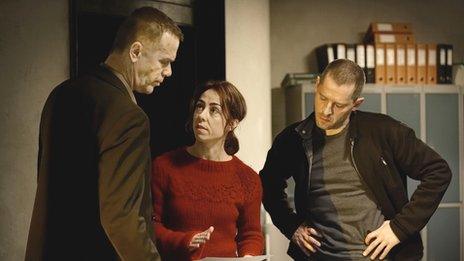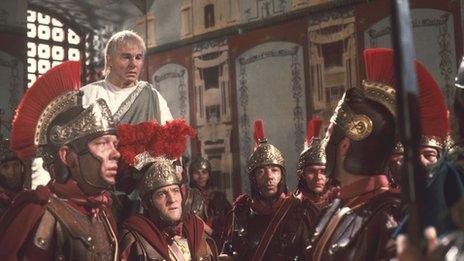Is slow TV taking over the airwaves?
- Published
- comments

The return of Danish drama The Killing to television screens is the latest evidence of a shift towards long and glacially paced, small-screen drama. So why has slow TV taken off?
It's hardly The Sweeney. Car chases and explosions are thin on the ground. Sensational weekly denouements and wild plot twists are conspicuous by their absence.
The Killing's gradual, deliberate pacing seems to flout the conventions of the prime-time television crime thriller - a feature that puts it in company with other, similarly unhurried recent hit programmes.
Brooding, Pinter-esque pauses abound and violence, when it occurs, is downplayed. Dark, rainswept settings frame a mood of near-endless gloom. In its first series, the investigation of a single murder is played out over 20 hour-long episodes.
Returning for a second series on BBC Four, the abiding characteristic of the programme is its slowness. But it's not "slow" in the normally derogatory sense, but rather slow in the sense of crescendoing. It's proved a global hit and has already earned a US remake.
There are plenty of US shows that now adhere to the "slow TV" template. The Killing was preceded by Mad Men, a series whose lack of velocity makes the Danish thriller look like Walker, Texas Ranger.
In Matthew Weiner's 1960s-set serial - shown in the US on AMC and about to be a flagship series for the UK's Sky Atlantic - the focus is firmly on tone, mood and character development at the expense of plot-points. Entire episodes pass by in which relationships may subtly alter and themes of identity, alienation and social change be explored, but very little actually happens.
The widely hailed novelistic style of HBO's The Wire saw story arcs rise and fall across series. Though the Baltimore-set crime drama may have had its fair share of action, eventually, writer David Simon's follow-up, Treme, about the aftermath of Hurricane Katrina, was profoundly slow-paced.
Such is the influence of this kind of drama that the Mail on Sunday ran an article criticising ITV1's flagship Sunday evening costume drama, Downton Abbey,, external for apparently unwelcome "breakneck" pace in the second series.
Slow-tempo TV is hardly new, of course. Series like the 26-part Forsyte Saga and the TV version of Tinker Tailor Soldier Spy unfolded gradually. Granada Television's classic 1980s dramas Brideshead Revisited and The Jewel in the Crown spread out over 11 and 13 hours respectively.
And two decades ago international audiences embraced Twin Peaks in huge numbers despite its lack of urgency in revealing Laura Palmer's murderer.
But what distinguishes the current incarnation of slow TV is that it flies in the face of conventional wisdom about modern audiences demanding immediacy, their attention spans sapped by the ever-moving online era.

The Killing is unashamedly long and slow
Instead, it appears that a significant proportion of the viewing public have responded to the instant gratification culture given expression by Twitter and YouTube by demanding quite the opposite.
Indeed, for screenwriter Abi Morgan, who wrote the BBC's The Hour and the forthcoming Margaret Thatcher biopic The Iron Lady, the current popularity of slow TV is itself driven by technological development.
"The box set is slowly revolutionising the way we watch TV," she says. "Audiences are choosing to watch in their own time. That really allows us to appreciate these long-running shows."
Certainly, fans of such shows frequently compare the viewing experience to that of reading a book, with The Wire's creators in particular claiming to have consciously framed their stories using literary rather than televisual plot structures.
As such, the pace of slow TV invites viewers to actively engage with the programme, rather than their normal treatment as passive, argues Dr Amy Holdsworth, lecturer in film and television studies at the University of Glasgow and an expert in small-screen history.
"Part of the appeal is working things out for yourself," Dr Holdsworth adds. "They allow the space for viewers to invest in them and make connections for themselves.
"These days there is definitely more of an appreciation of what you can do with TV as a form - you can have so much more character depth in 80 hours than you can in a two-hour film."
Nonetheless, the format has not always proved popular. US subscription channel HBO's atmosphere-driven serial In Treatment received relatively modest ratings, while AMC's atmospheric espionage slow-burner Rubicon was cancelled by the network.

The Forsyte Saga reportedly led to empty pubs and churches on Sunday nights
One reason for this, suggests Boyd Hilton, TV editor with Heat magazine, is that making such a programme successfully is hugely difficult to execute, requiring skill and technique to hold the audience's attention.
As such, he questions whether the better-faring examples of the genre really are as slow as we think they are.
"I'd dispute whether they are really glacial," he says. "With The Killing, there's a crime in the first episode and it plays out like a crime thriller, albeit with a dense storyline and dense characters - every single scene imparts the story or the characters in some way.
"It doesn't always work. I found the second series of The Wire, the one set in the docks, quite boring, because I wasn't really interested in that world."
Fans may differ about which aspects of their favourite slow TV shows work and which don't - fuelling a mini-industry of discussion forums and blogs.
But at least part of these programmes' appeal, Hilton adds, is the knowledge that one is consuming a work of art rather than a mere TV thriller or crime drama.
"There are some, but not all, who would take great pride in the fact they are watching something more multi-layered and nourishing than the supposedly lowest common denominator stuff that's out there," he says.
True, no-one could confuse Mad Men's delicately crafted Carousel scene - in which anti-hero Don Draper's advertising pitch to a group of slide projector executives reveals at once the protagonist's cynicism, inner anguish and lack of any kind of fixed identity - with an episode of the X Factor.
But the pacing of such a programme, it could be argued, owes much to another genre of popular entertainment.
With their immersive settings, long-running plotlines and characters who interact with each other over years rather than hours, slow TV shows could owe more to the likes of Coronation Street and EastEnders, Dr Holdsworth suggests, than many of the former's viewers might care to admit.

The life of Claudius would be hard to shoehorn into six episodes
"In terms of a long-running serial with a narrative arc, I would argue that soap opera has been doing it for a long time," she says.
"People use it as a pejorative term, but the Sopranos is essentially using the form of soap opera."
For all that the likes of Mad Men have been enthusiastically reviewed and received in the UK, however, the country is yet to produce similar long-running slow TV of its own for the 21st Century. While such dramas as Stephen Poliakoff's Shooting the Past may have been slow to unfold, it lasted three episodes, compared with The Killing's 20.
Indeed, while it is common for US cable drama series to be commissioned in 12-14-episode blocks, the norm in the UK is still much shorter runs.
Morgan believes the British TV industry currently lacks the capacity for such long-form entertainment. But she is confident that the appetite is there - among viewers, dramatists and critics alike.
"American writers are executive producers on shows they originate. We don't have that infrastructure," she says.
"But what's interesting about The Killing is that it's a northern European show. I predict it will happen here in the next few years - I think there's the ambition to do that."
If so, it will represent a slow-burning drama of its own. Perhaps the makers of Downton Abbey will take heed.